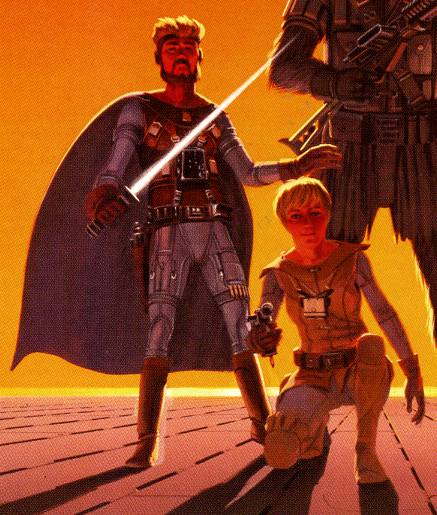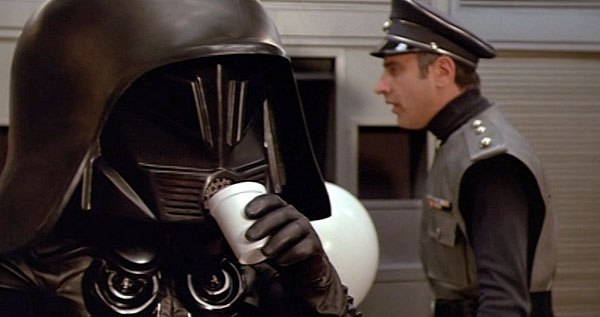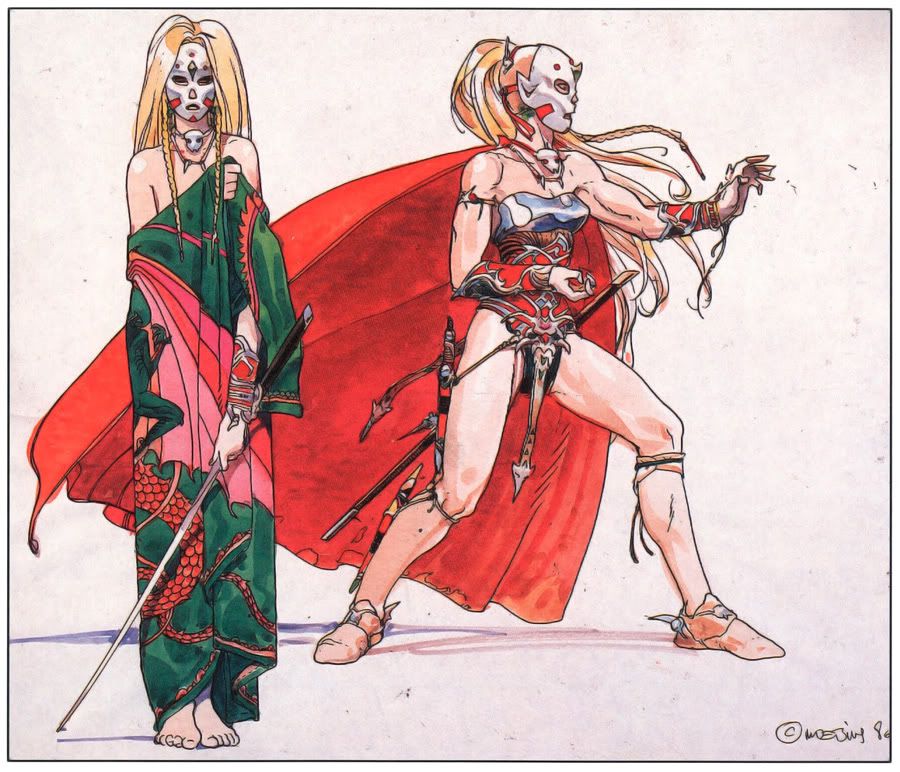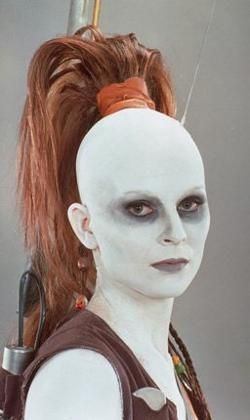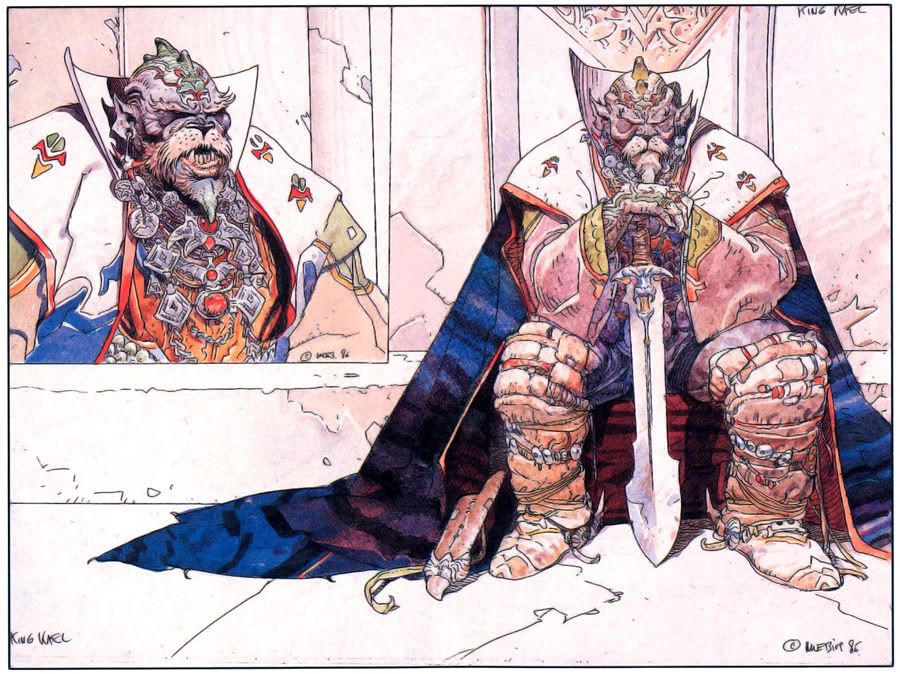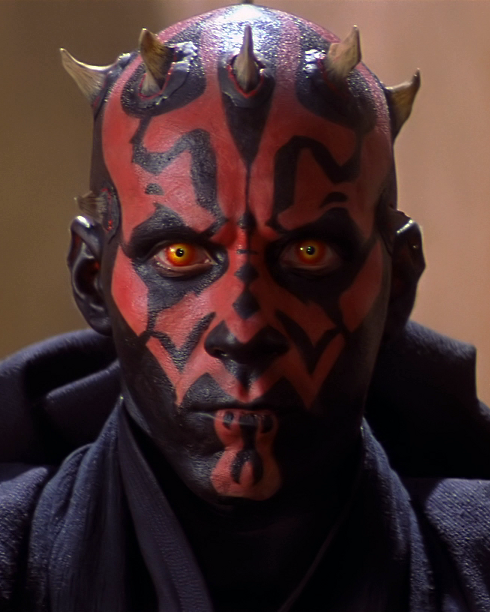I've done something like this before, but since my knowledge of the SW rough draft has since increased greatly, I thought I'd have another go.
George Lucas's 1974 rough draft for The Star Wars is full of interesting visual images. Sadly, since the draft is on paper and was never illustrated, many of these images have gone unremarked. I hope in this post (really rather an essay) to illuminate some of those visuals--which is best done, in many cases, by probing into the origins of various elements of the script.
The best way to approach this, I think, is to provide a detailed summary of the script, illustrated throughout by pictures that show just what Lucas had in mind for the look of the film. Accordingly, this will be a long and image-heavy post.
---
The rough draft's principal protagonist is the eighteen-year-old Annikin Starkiller. The script tells us that Annikin and his father, Kane, wear their hair long, in "an odd bun" on top of their heads. This hairstyle is said to be picked up from the inhabitants of the Kessil System, where the Starkillers lived as fugitives for a time.
This "bun" is, in fact, a samurai topknot, and Annikin is meant to resemble Toshiro Mifune in his various samurai roles. This means that Lucas probably imagined Annikin as having black hair.
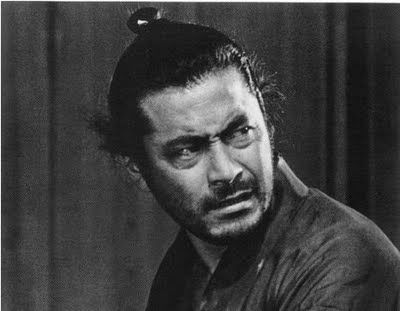
As the pupil of a venerable elder Jedi, Annikin also recalls Katsushiro, the young apprentice samurai in Akira Kurosawa's film Seven Samurai.
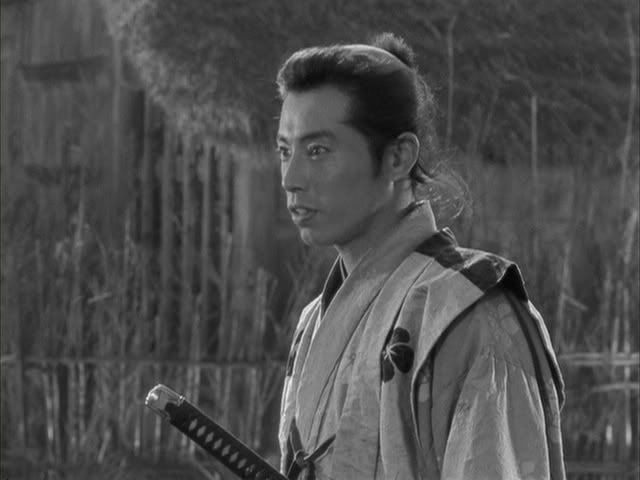
The image of the black-haired warrior figure recurs in Lucas's later work, both in Willow and in early concept art for TPM.
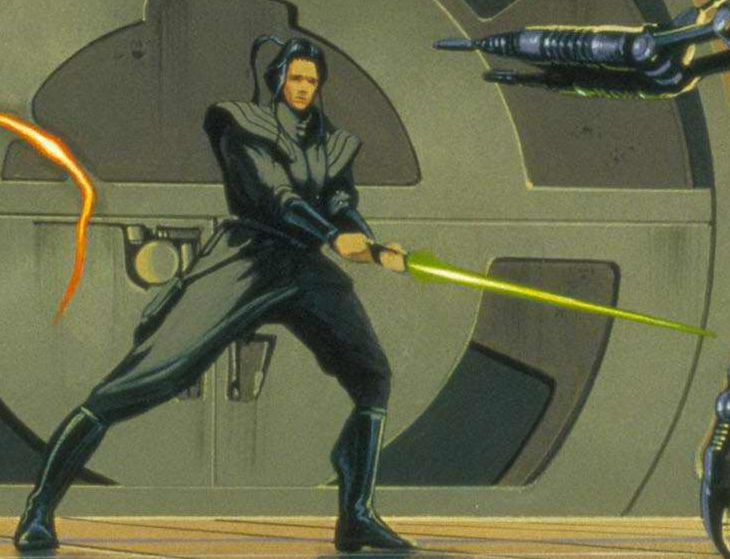
Given Lucas's apparent preference for blue-eyed heroes, Annikin likely has black hair and blue eyes, which would make him resemble the literary version of Conan the Cimmerian. Robert E. Howard's Conan stories appear to have been a notable influence on Lucas's early drafts of SW.
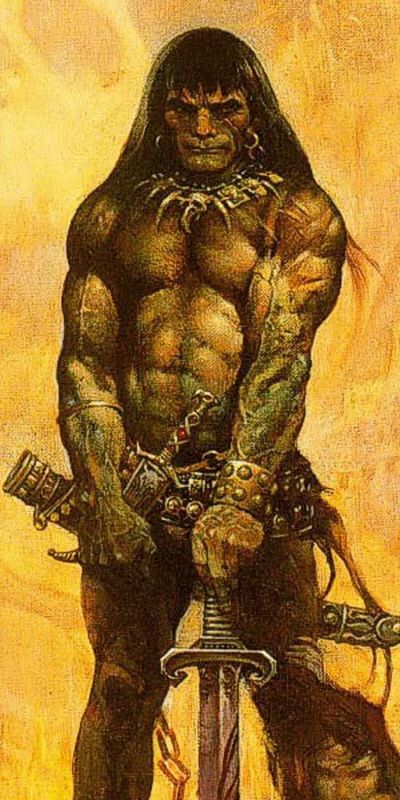
Early in the script, Annikin ends up engaged in a lightsaber duel with a Sith on an arid, desolate planet. The equivalent scene in the second draft (now set aboard a spaceship) would be immortalized in art by Ralph McQuarrie.
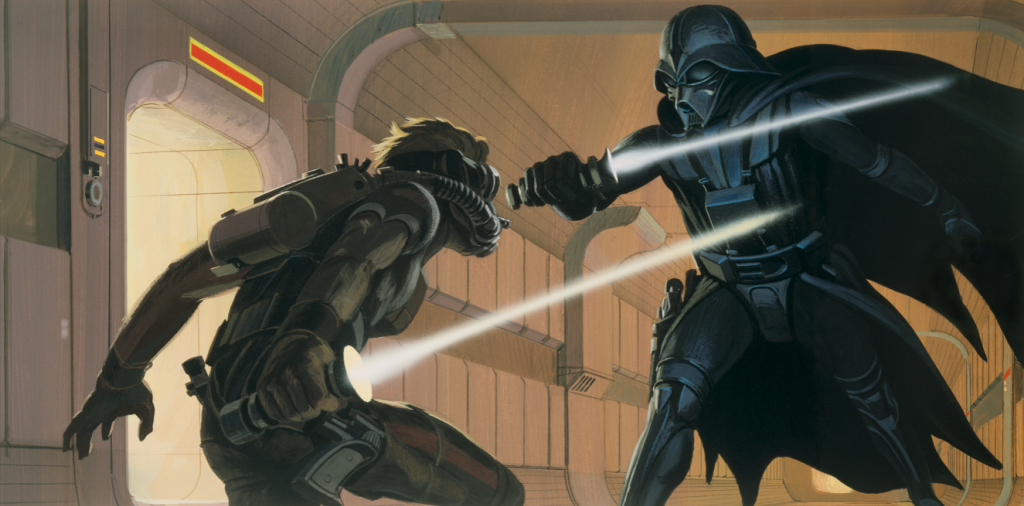
Both Annikin and his Sith opponent are wearing breathing masks, as the air of the planet shown in the film's first scenes is unsuited to humans. These masks are meant to be reminiscent of samurai battle masks.
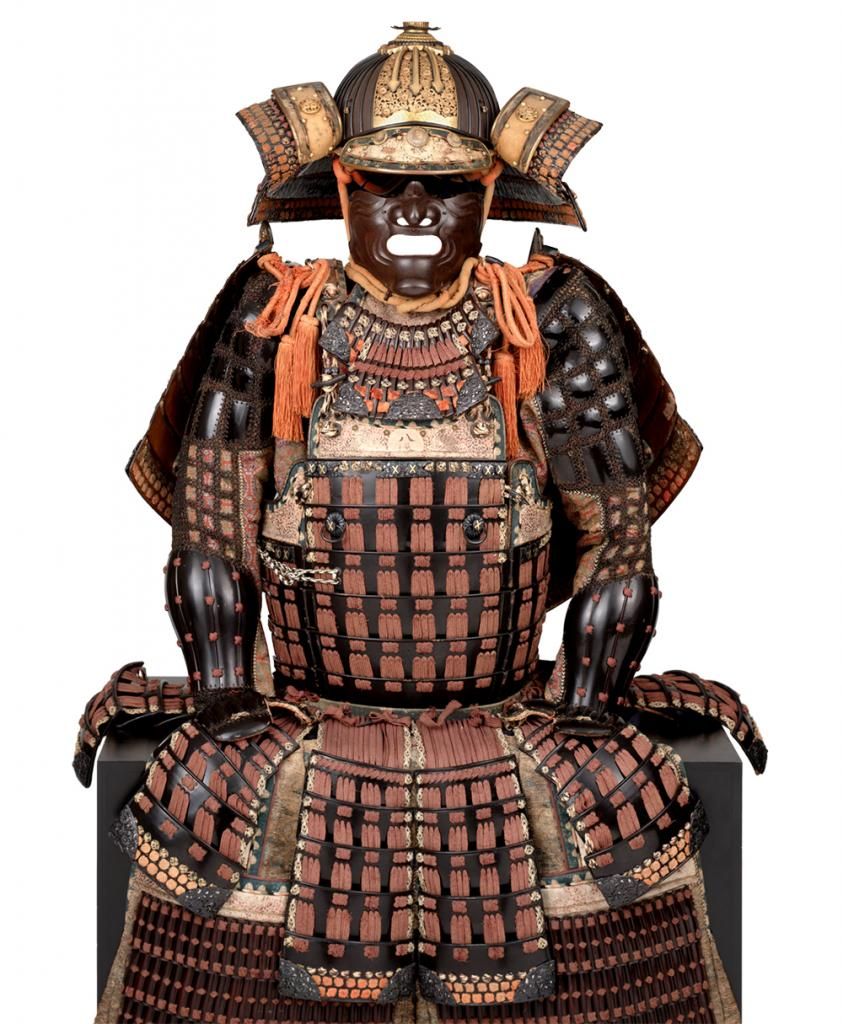
In this draft, Jedi and Sith do not have telekinetic superpowers. That came later--in the second draft, to be precise. At this stage, the Jedi are ferocious warriors because they have trained hard to achieve intense discipline of mind and body. But they are not superhuman, or genetically distinguished in any way from the general population.
(Once Lucas did give the Jedi telekinetic abilities, he began immediately to think of Jedi powers as a heritable genetic trait. In fact, the second draft portrays the Jedi as a set of families whose powers descend from father to son, much in the vein of the Bene Gesserit matrilineal bloodlines from Dune. And, just as Paul Atreides was the opposite-gender culmination of the Bene Gesserit matriarchs' breeding program, Lucas gave serious thought to revising the second draft to make Luke Starkiller a girl.)
Oh, and in the rough draft, everyone's lightsabers are red in color. Which was faithfully reproduced by (most of) the sabers in the recent Dark Horse comic adaptation.
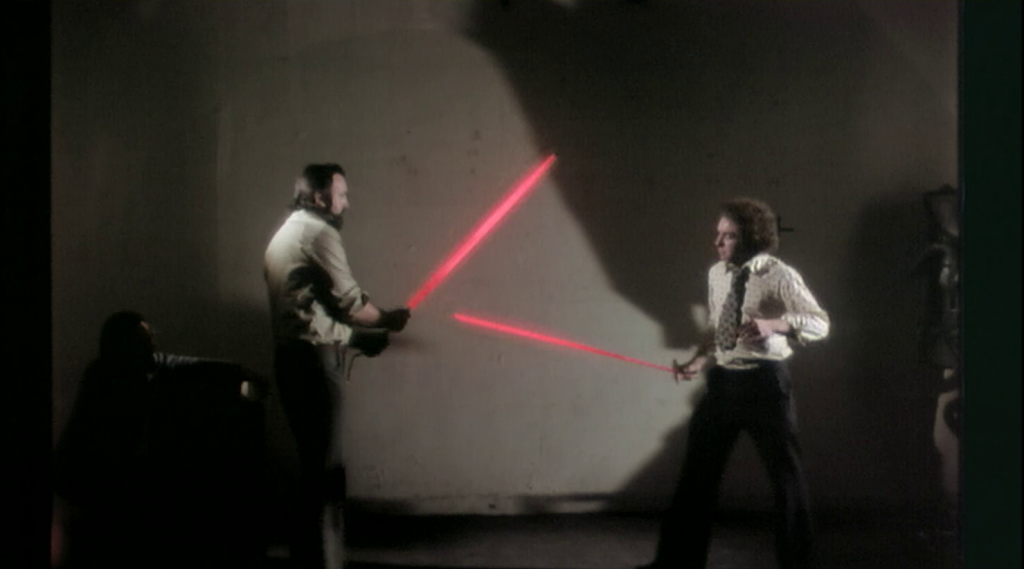
Annikin's younger brother Bink, only ten years old, is killed by the Sith warrior. Bink is described as having "dusty blond hair," so presumably he is the very earliest prototype of Jake Lloyd's nine-year-old Anakin Skywalker.
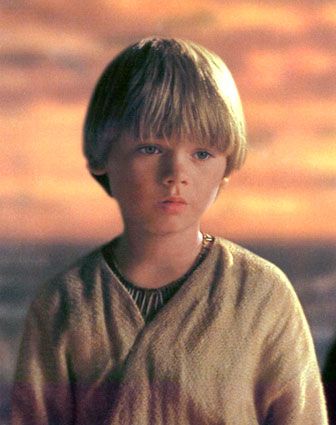
After they bury Deak, Annikin and his father Kane return after long voyaging to their home planet of Aquilae.
The script now shifts focus to Alderaan, a cloud city on the capital planet of the Galactic Empire. The image of the floating city in the clouds is obviously inspired by the Sky City of the Hawkmen from Flash Gordon.
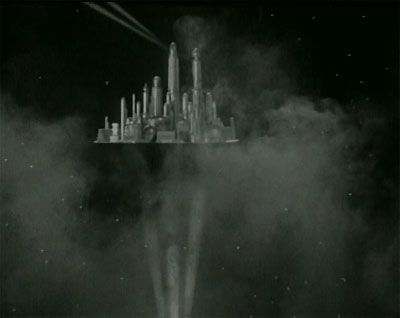
We are introduced to the city of Alderaan by a squad of two-man "stardestroyer" fighters flying overhead, as the evil Emperor makes a speech announcing the imminent invasion of Aquilae, in front of a massed army of troops in black uniforms.
The two-man craft would recur as the twin-pod cloud cars seen in Bespin in ESB. Presumably the early concept art for that craft, which made it triangular in shape like a full-size Star Destroyer, was influenced by the SW rough draft.
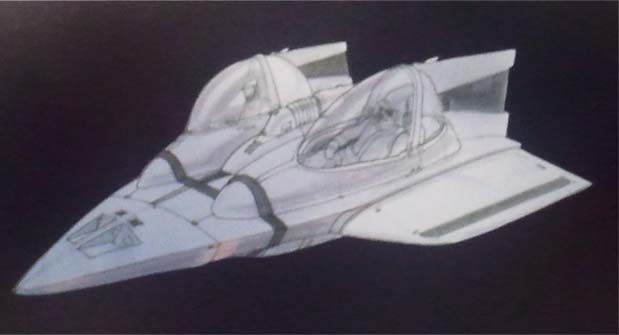
In fact, this scene on Alderaan is meant to recall the opening of Leni Riefenstahl's infamous Nazi propaganda film Triumph of the Will, in which Hitler descends from the clouds down to Nuremberg via airplane. The Emperor here is even described as having a Hitler-style mustache.
However, the Emperor's speech contains lines taken from the diary of John Adams. This serves to indicate how Lucas conceived the Empire: a vision of an America that has been corrupted and fallen from its once-noble ideals.
We also first encounter here another heroic character, observing the scene: Clieg Whitsun, "a tall, blond young man about twenty years old." Whitsun is something of a prototype of the final film's Han Solo. He fights alongside Annikin Starkiller in several battles, wielding a lasersword and laser pistol, but is distinguished from Annikin by not being a Jedi warrior.
Given Clieg Whitsun's blond hair, and the syllabic sound-similarity of his name to that of Flash Gordon, it's safe to say that Lucas intended Whitsun to physically resemble the Flash of Alex Raymond's comic strip.
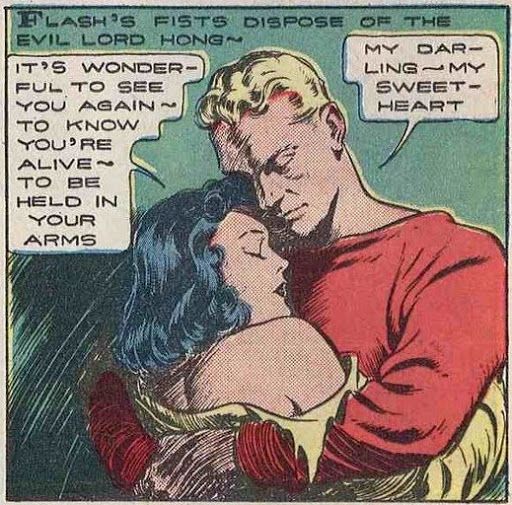
In later drafts, this property would be transferred to chief protagonist Luke Starkiller/Skywalker, who would no longer be black-haired. Han Solo, on the other hand, would have brown hair like Buck Rogers.
Over the course of the script, Clieg Whitsun accompanies the party of fleeing rebels until they are forced to abandon their damaged spaceship in orbit over Yavin; there he sacrifices his life to save Princess Leia.
Following the speech there is a scene where we see Imperial bureaucrats plotting the upcoming invasion of Aquilae. Chief among them is the newly appointed governor of the soon-to-be-conquered territory, Crispin Hoedaack, a Grand Moff Tarkin figure. Hoedaack is "a young, treacherous man with stone-cut angular features and piercing grey eyes." His henchman is Darth Vader, at this stage conceived only a "a tall, grim-looking general."
The Imperials' quarters are described as "white-on-white," an image of sterility and lifelessness that recurs from THX 1138.
On Aquilae, we are introduced to the commander of the Aquilaean King's armies, General Luke Skywalker. Skywalker is "a large man, apparently in his early sixties, but actually much older. Everyone senses the aura of power that radiates from this great warrior. Here is a leader: a JEDI general. He looks weary, but is still a magnificent looking warrior. His face, cracked and weathered by exotic climates, is set off by a close silver beard, and dark, penetrating eyes."
Unlike Kane and Annikin Starkiller, the Jedi warrior Luke Skywalker does not wear a samurai-esque topknot. Along with the color of his white hair, this connects him visually with Kambei Shimada, the gray-haired lead samurai in Seven Samurai, who shaves off his topknot at the beginning of the film as part of a disguise used to rescue a small child from a bandit.
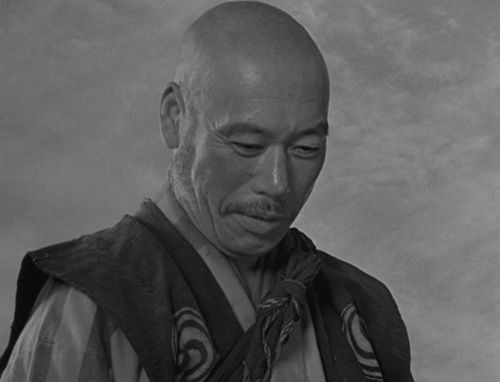
The short hair and beard of Luke Skywalker also visually connects him with Clint Eastwood's Man With No Name from Sergio Leone's films. Lucas stated that he envisioned the General character as "a seventy-year-old Clint Eastwood."
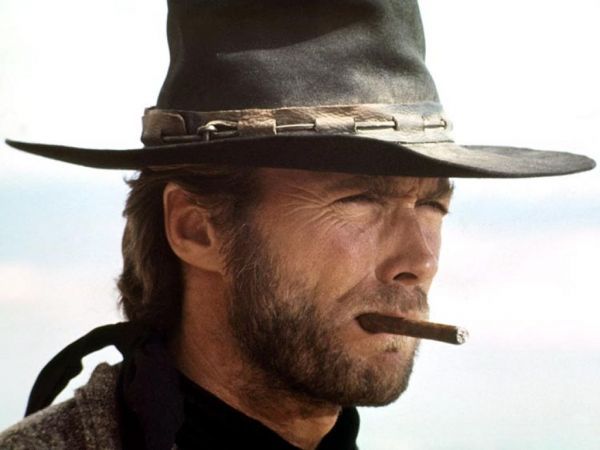
However, despite the Clint Eastwood connection, General Skywalker is presumably meant to be Japanese, as proclaimed by his dark eyes.
We also meet the King's fourteen-year-old daughter, Leia Aquilae. She is described as having "long auburn hair tied in braids" (i.e., red hair) and blue eyes.
The braids may already have been conceived as being like those of the final film's Leia, whose hairstyle recalls the Nordic braids of Queen Fria from Alex Raymond's Flash Gordon.
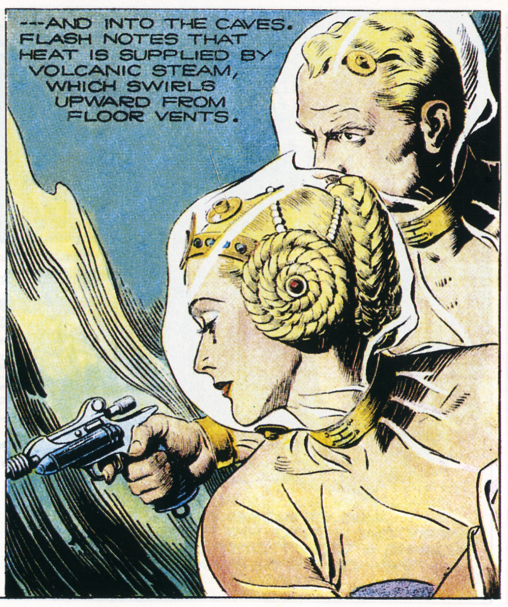
Leia's red hair comes from several sources: most notable are probably Princess Alia in Dune Messiah and Princess Aura (and Queen Desira, shown below) from Flash Gordon.
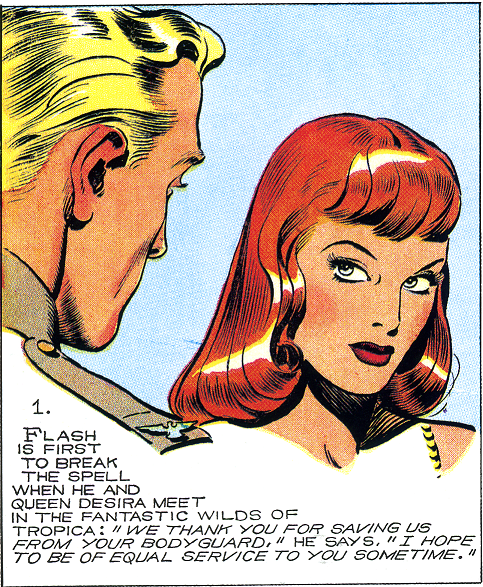
Leia's stated age (14) is taken from that of Princess Yuki, the heroine of Kurosawa's film The Hidden Fortress, who like Leia becomes a fugitive on the run from enemy troops.
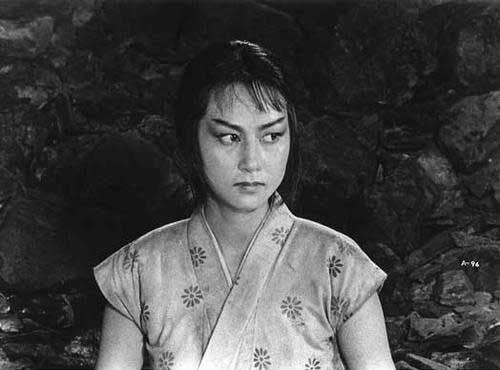
Lucas likely already imagined Leia as wearing the white dress she has in the final film.

As Ralph McQuarrie noted, this dress is in fact deliberately designed in order to resemble the robes of the Virgin Mary. Goddess symbolism permeates Leia's character throughout the various drafts of the film; she is the divinity whose cause the heroes fight for.
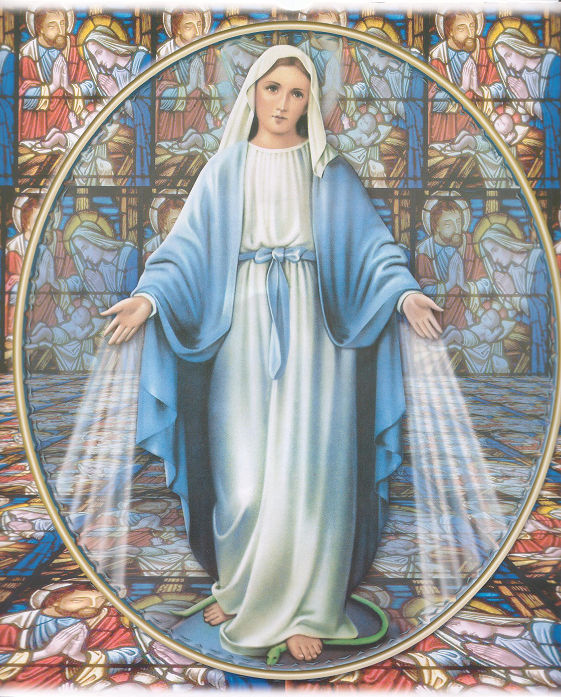
When the Starkillers arrive on Aquilae, Kane confesses to his old friend General Skywalker that he is dying and needs someone else to complete his son's Jedi training. This is because he is now almost entirely mechanical, as he dramatically reveals when he swings his left arm down on a table and android parts spill out.
This imagery is very probably borrowed from Star Trek. In the TOS episode "What Are Little Girls Made Of?" Kirk gets into a fight with Dr. Roger Korby, the long-lost and presumed-dead fiancé of Nurse Chapel. Kirk tears the skin off of Korby's left hand, revealing android circuitry beneath. Korby then explains that he preserved his consciousness in an android body when his original body died.

Later in the script, in the scene where Kane Starkiller dies, he opens his chest and reveals a panel of circuitry. Here Kane says of himself that there is "nothing left but my head and right arm." He is literally "more machine than man," just like Luke's father in the finished SW trilogy.
Annikin Starkiller is inducted into the service of the King of Aquilae. This entails him donning "the white uniform of the Aquilaean starforce." However, he still keeps the "Kessilian hair knot" (i.e., the samurai topknot).
Obviously the main protagonist of the film was already conceived by Lucas as wearing white, just like Luke Skywalker as ultimately portrayed on screen.
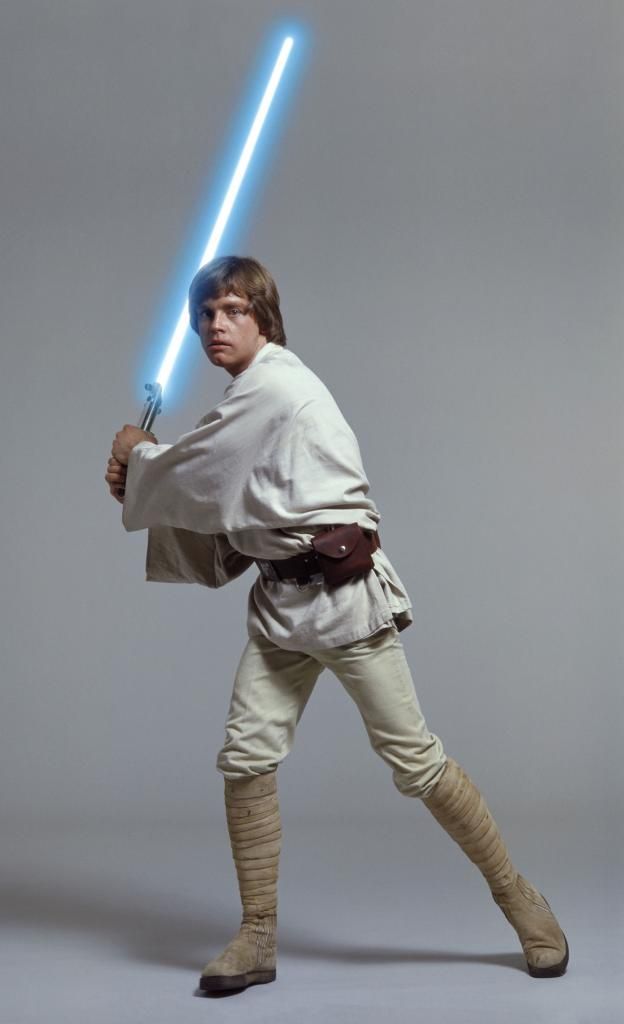
(This goes back to my point earlier about Leia likely already wearing a white hooded dress.)
Incidentally, in the revised rough draft (though not the initial version) the sky on Aquilae is described as green, a detail deriving from the desert planet of Altair IV seen in Forbidden Planet.
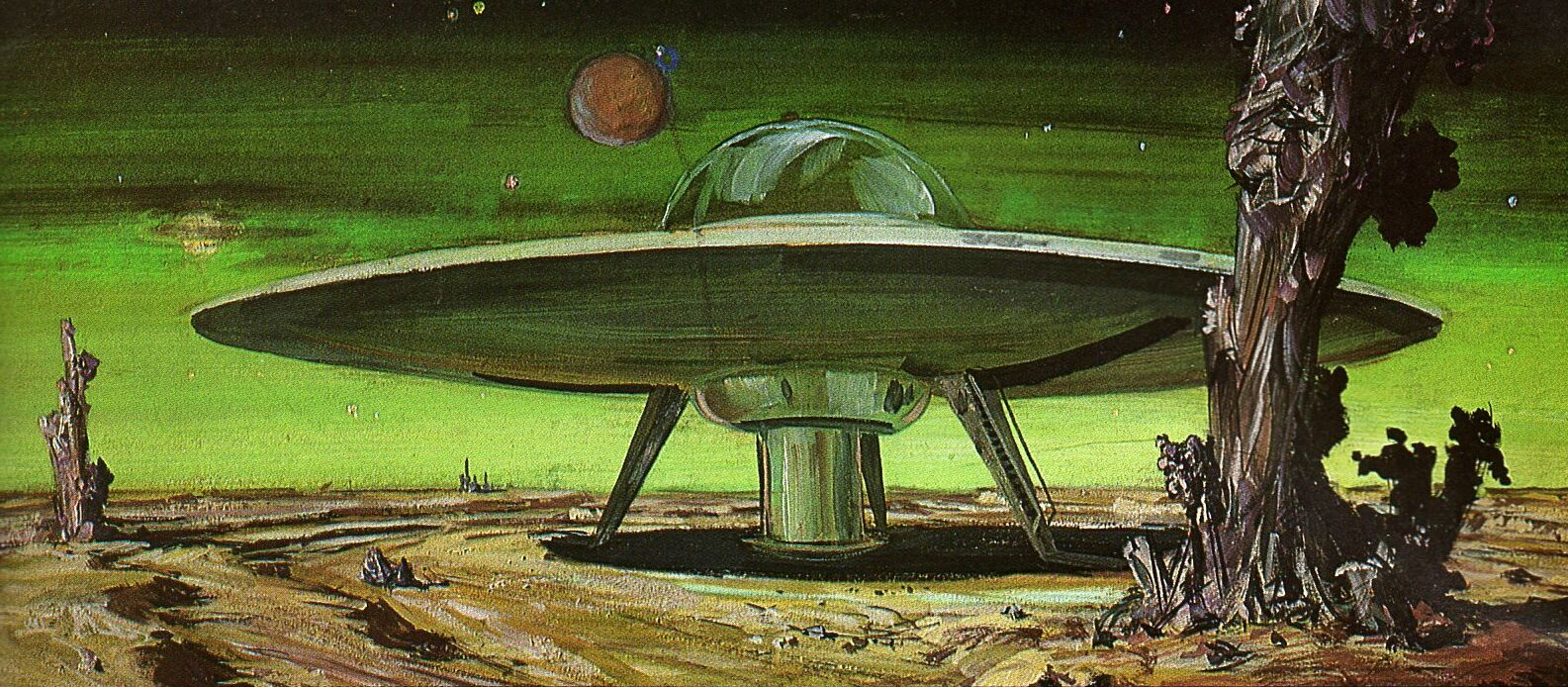
At one point, just before the Imperial invasion begins, Annikin has a sexual dalliance in a closet with a female aide of the King's military staff. This is obviously derived from a scene in Seven Samurai where Katsushiro has sex in a barn with Shino, a peasant girl with whom he has fallen in love, the night before the final battle to save the peasants' village.
Clieg Whitsun arrives on Aquilae with proof that the Empire is planning to invade. General Skywalker dispatches Annikin Starkiller to bring Princess Leia back safely from the Academy where she is attending school. Annikin notices that Leia has a handmaiden, Mina, who has dark hair but otherwise resembles the princess.
As you can probably guess, Mina is passed off as a decoy Princess, when Annikin puts Leia's royal medallion around her neck. This idea, which would recur in a more fleshed-out form in TPM, originates in The Hidden Fortress. In that film Toshiro Mifune's character (General Rokurota Makabe) sacrifices his own sister as a substitute for the outlawed Princess Yuki.
When the Imperials invade, Princess Leia's father, King Kayos, returning from a meeting with his legislature, is killed by a nuclear weapon. The use of atomic bombs, which would disappear from the SW universe after this draft, recalls their presence in Frank Herbert's Dune series.
Meanwhile, General Skywalker assembles the squadrons of Aquilae's starfighters for an attack on the planet-sized Imperial space fortress orbiting overhead.
The starfighters are described as "sleek" two-man starships. I would guess they resemble the silver Naboo spaceships of the prequels, whose aesthetic was borrowed from the 1930s Flash Gordon serials.
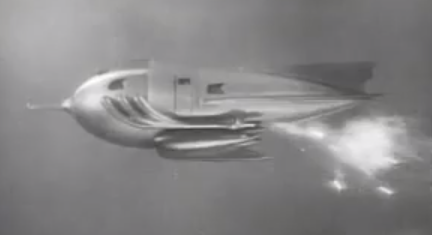
In fact, in the first draft of TPM, Lucas described the Naboo fighters as two-man craft, with Anakin and Padme piloting one together in the final battle.
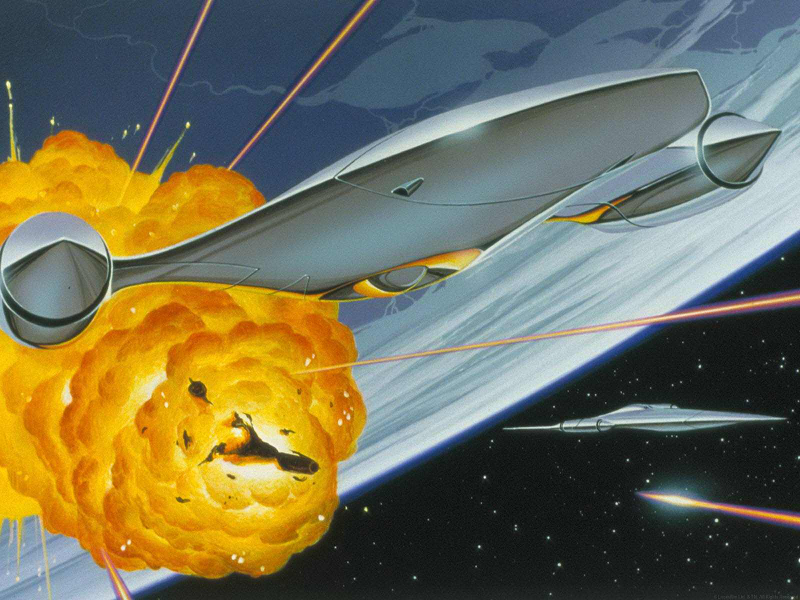
The pilots themselves wear white jumpsuits, keeping with Lucas's use of white clothes for the heroes and black for the villains, like in a Western. On their suits is the symbol of Aquilae, said to be the "distinctive circle-and-cross medallion."
This probably refers to the alchemical symbol for Venus, which represents femininity, fertility, and love (as opposed to war, the domain of Mars--represented by the Imperials). The Venus symbol also bears a strong resemblance to the ancient Egyptian ankh, the symbol of life and rebirth.
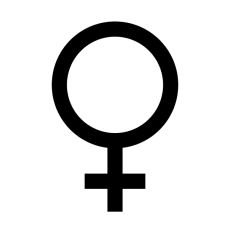
During the space battle, two worker robots on the Imperial space station, frightened by the damage occurring, eject in a lifepod to the surface of Aquilae below, where they are picked up by Annikin Starkiller. These are the rough draft's versions of R2-D2 and C-3PO.
Threepio is described as a "chrome android." The chrome color refers to the appearance of the robot Maria in Metropolis, as it looks on black-and-white film. In later drafts Lucas would describe Threepio as "bronze" instead, this time referencing the color the Maria robot was actually painted on the set of Metropolis.
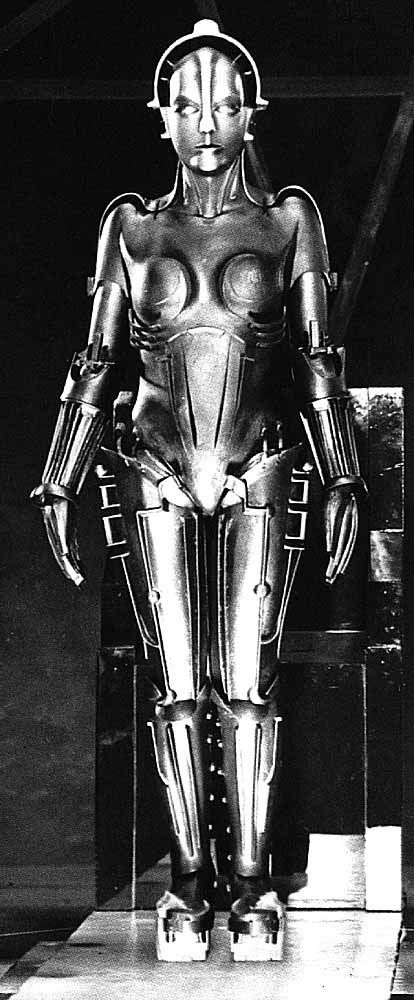
R2-D2, on the other hand is a "short (three feet) claw-armed tri-pod" with a "radar eye."
Now, Ralph McQuarrie basically designed the final film's Artoo from the ground up. McQuarrie's idea was that, since the obvious inspiration for the later Artoo was the diminutive, non-speaking worker robots in Silent Running--which were rectangular, like a Gonk droid--he'd design something cylindrical instead, just to be different.
However, unlike the Silent Running-inspired Artoo of later drafts, the rough draft's Artwo-Detwo speaks perfect English. And Ralph McQuarrie of course hadn't come along yet.
I actually believe the inspiration for the original appearance of Artwo in the rough draft was the Martian tripods (or "fighting machines") from H.G. Wells' novel The War of the Worlds.
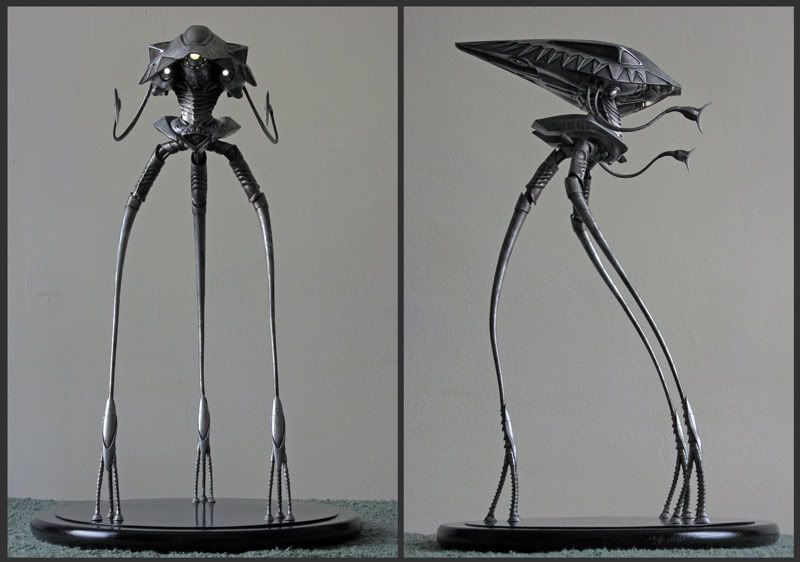
Like Artwo, Wells' tripods have three legs, as well as numerous flexible arms with which to grab objects. Their "heads" also usually are depicted with a single giant "eye," actually a lens from which they project a lethal Martian heat ray.
If Lucas indeed scaled down the Martian tripods of Wells' book to create a believable non-anthropomorphic construction robot, it would be of a piece with what he did with C-3PO. After all, the robot in Metropolis was presented as a villain. In both cases, we glimpse a recurring theme of the rough draft: the monsters of older SF are recast by Lucas as heroes.
With the King dead, the nobles of Aquilae decide to capitulate to the Empire. Still defiant, General Skywalker begins making plans for the escape of the royal family from the invading Imperial army.
In order to secure the support of "the chrome companies" for Leia's restoration to the throne of Aquilae, Skywalker is entrusted with capsules containing the DNA and recorded memories of 33 prominent Aquilaean scientists. These samples, suitable for creating clones, will be turned over to the chrome companies as the price of buying an army to restore the planet's freedom.
This plot element virtually disappears after this point in the script, as the eventual destruction of the Imperial army is brought about not by the chrome companies' hired forces, but by an army of Wookees. However, the prominence of cloning and corporate guilds as elements in this early script shows clear echoes of Dune.
The party of fleeing rebels consists of General Skywalker, Annikin Starkiller, Princess Leia, Clieg Whitsun, the droids, and Leia's two younger brothers. Kane Starkiller is not present, as he is already in the spaceport of Gordon, arranging for transport off-planet.
The rebels leave behind the underground command chamber from which Skywalker had run the war, and the complex (in which Leia's mother the Queen has remained) is then blown up by an atomic bomb. This is done deliberately, so as to prevent it falling into Imperial hands.
This is modeled once again on The Hidden Fortress, where, after the party escorting the fleeing princess leaves behind their hidden mountain refuge, the enemy surrounds it. At that point the fortress's remaining defenders set it ablaze and perish rather than fall into unfriendly hands.
The "black knight of the Sith" assigned by the Empire to hunt down the Aquilaean royal family is Prince Valorum, who is "dressed in the fascist black and chrome uniform of the legendary Sith One Hundred."
Valorum's uniform--black against the white walls of Imperial architecture--is once again borrowed from the imagery of THX 1138.
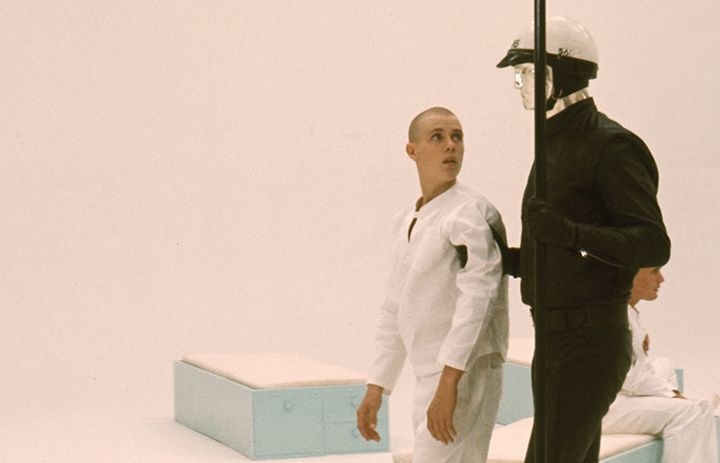
As for what Valorum himself looks like, I suspect Lucas wanted the Jedi and Sith knights to be a racially diverse group. As such, Valorum would quite possibly be cast as an African-American, after the fashion of Mace Windu in the prequels.
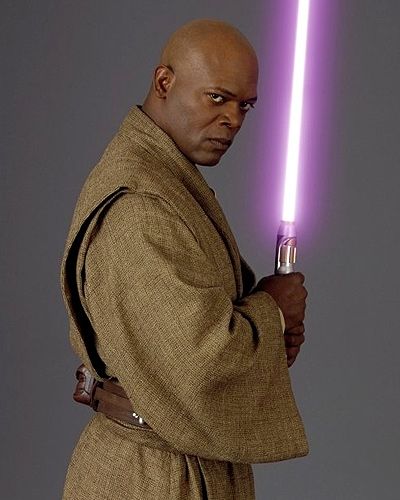
Both Valorum and Mace Windu are honorable warriors who are nonetheless strict in temperament, overly bound by reverence for rules. Valorum mends his ways and becomes a hero, but Mace Windu fails to realize his errors, which leads to his death.
This also would lead to a racially diverse group of heroes being presented in the film's celebratory final scene. Along with the various non-human creatures, there would be Annikin and Leia, General Skywalker, and the reformed Prince Valorum--human heroes from three distinct racial backgrounds who have come together in harmony to defeat the Empire.
The idea of portraying Valorum as black would also explain the casting of James Earl Jones as the voice of Valorum's successor character in the finished film of 1977: Darth Vader (who of course was not yet Luke Skywalker's father).
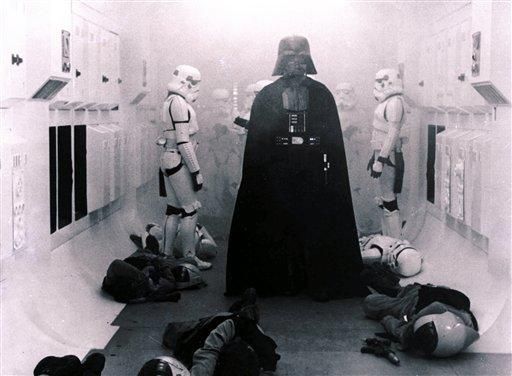
Once the heroes reach the city of Gordon (named for Flash), we get an early version of the cantina scene, in which General Skywalker is bothered while having a drink, and proceeds to cut an alien's arm off. The dialogue in this version is even more nakedly borrowed from Kurosawa's Yojimbo than in the final film.
When we re-encounter Kane Starkiller, he introduces us to his contact with the anti-Imperial underground, Han Solo. Han is "a huge, green skinned monster with no nose and large gills." In other words, he is a swamp creature, modeled on the Creature from the Black Lagoon. Here, too, Lucas has recast an earlier film's monster as one of his heroes.

Han Solo's physiology also recalls the gigantic Green Martians from Edgar Rice Burroughs' Barsoom series, several of whom the hero John Carter befriends over the course of the books.
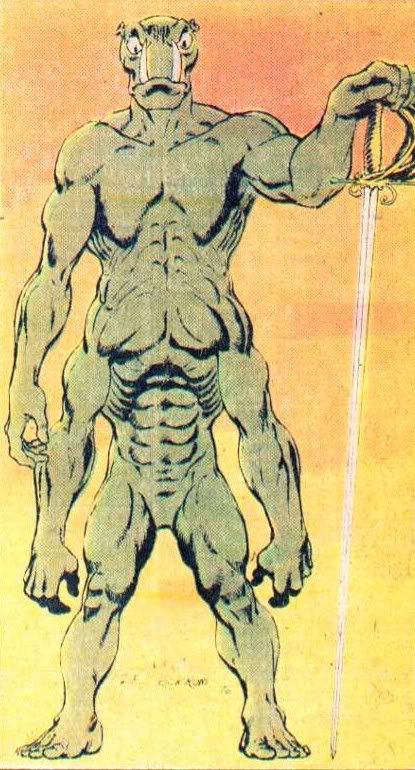
As the monstrous sidekick of the human heroes, the rough draft's Han Solo is the forerunner of the final film's Chewbacca. However, unlike Chewbacca, here Han Solo speaks perfect English.
The swamp-creature Han Solo of the rough draft would later provide inspiration for Yoda (who is shrunk down to diminutive size, just as the Ewoks of ROTJ are smaller versions of the SW rough draft's Wookees); as well as Jar Jar Binks, who was originally imagined as green.
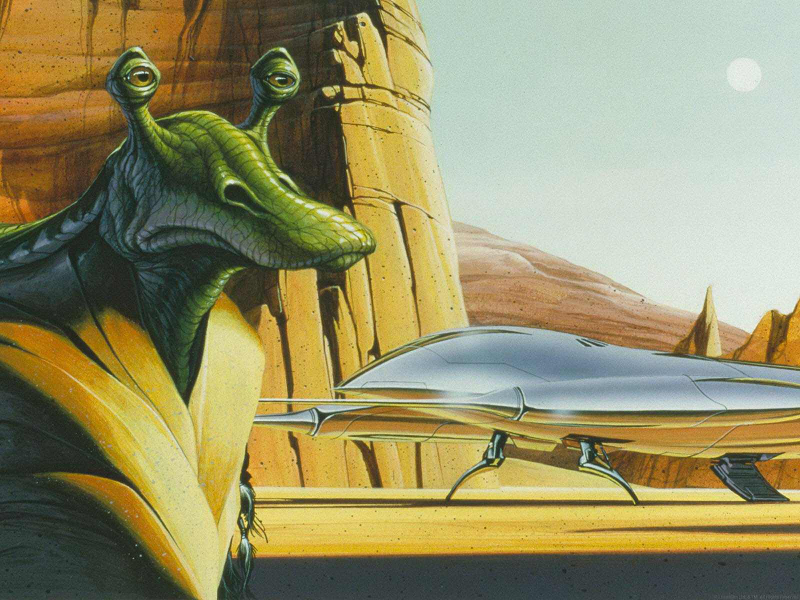
The heroes need to transport Leia's two younger brothers in small cryogenic chambers, so they can be moved easily and without fuss. However, there are not enough power units available in the Imperial-controlled city to power both of their cryo-packs.
Kane Starkiller solves this issue by opening a panel in his chest and ripping the power pack out of his mechanical innards. He dies shortly afterward, making the ultimate sacrifice for the greater good.
The image of Kane opening his chest to reveal a panel of circuitry likely has roots in another Star Trek TOS episode, "Mudd's Women," where we see an android who does the same thing.
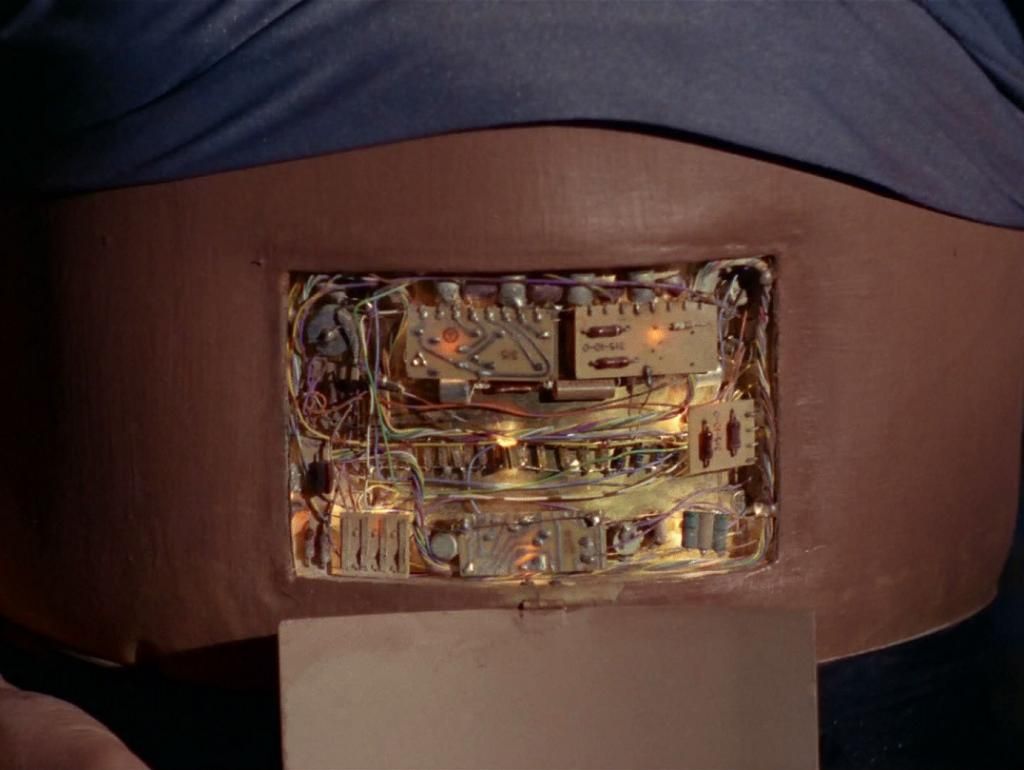
Prince Valorum lays a trap for the heroes at the spaceport, but they escape and take off in a military spaceship. Valorum's failure recalls the humiliation of his model from The Hidden Fortress, General Hyoe Tadokoro, who fails to capture Princess Yuki and General Makabe.
The spaceport is imagined as an underground facility, and the spaceships are protected by silo covers, like Cold War missiles. The heroes' ship blasts through this outer cover, sustaining light damage in the process.
As the stolen spaceship travels onward, tracked by Imperial fighters, Leia confesses that she loves Annikin. Annikin realizes that he, too, is in love with her.
When Imperial fighters catch up with their spaceship, Annikin and Whitsun (the equivalents of the final film's Luke and Han) put on spacesuits and man the laser turrets to destroy the approaching craft.
The spacesuits prove useful when Annikin's turret is blasted open by laser fire, and he is thrown into space, kept from floating away only by a single thin tether. Artwo-Detwo goes out into space and helps Annikin back into the craft.
This scene is borrowed from a similar one in Destination Moon, a 1950 film about a fictional Moon expedition, where one character is nearly lost during a spacewalk outside the rocketship and another must come to his rescue.
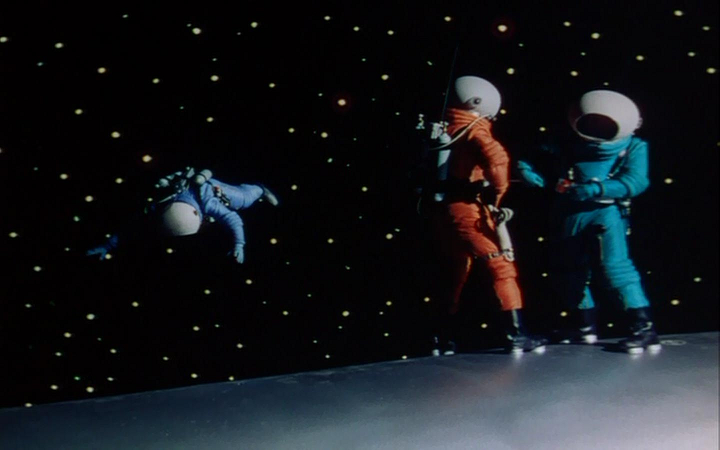
To evade Imperial pursuit, the general turns the starship into an asteroid field. However, the ship is so severely damaged by the asteroids that the heroes are forced to use the lifepods to bail out, heading for the surface of the nearby planet Yavin.
It is at this point that Clieg Whitsun sacrifices his life. When Princess Leia's lifepod fails to eject, Whitsun reconnects the damaged cables that control it, staying behind in the dying spaceship as the others bail out.
The lifepods come down at various points on the surface of the jungle planet Yavin; Annikin and Leia are each separated from the others.
Thrown out of his crashed lifepod, Annikin lies senseless in a tree when a disgusting insect creature begins crawling over him. His eyes open, but he lies still and silent for several long moments, until suddenly he grabs the creature in one swift motion and smashes it dead.
This scene appears to be borrowed from how James Bond deals with a deadly spider in Dr. No. The same scene would also provide the inspiration for the moment in Raiders of the Lost Ark where Indy deals calmly with a pack of large spiders.
Having killed the deadly insect creature, Annikin reunites with Artwo-Detwo and begins looking for Princess Leia. Meanwhile, the others revive Leia's two brothers from cryosleep, and begin searching for the rest of their party.
Finding Leia's lifepod empty, Annikin continues on until he finds a group of "scruffy alien trappers" sitting around a stove. The trappers have captured several Wookees, described as "huge grey and furry beasts," who are suspended by their ankles from tree branches.
The imagery of the Wookees--enormous furry ape-like creatures--appears to lean heavily on King Kong. However, the detail of their fur being gray seems to derive from the monstrous giant gray apes that appear as threats in several of Robert E. Howard's Conan stories, such as The Servants of Bit-Yakin and The Hour of the Dragon. In either case, the effect is that once again Lucas has turned a villainous monster into a heroic figure.
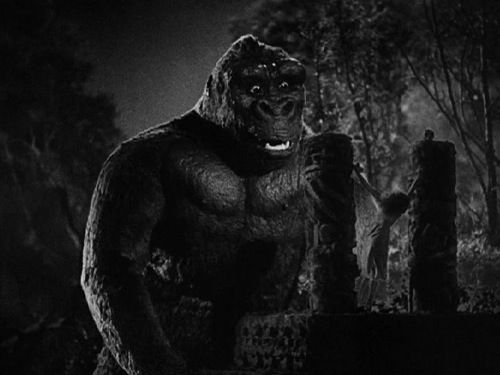
As Starkiller watches, one of the trappers enters his vehicle, then returns with Princess Leia, held "unconscious and half naked" over his head. Clearly he intends to rape her. Starkiller is so enraged by the sight of the partially nude Leia that he immediately leaps among the trappers and begins cutting them down.
Given that Lucas infamously told Carrie Fisher that "there's no underwear in space," I suspect that having Leia show off her underclothes wasn't what he had in mind here. Instead Lucas probably imagined Leia Aquilae as having had her top ripped off, leaving her bare-breasted like the heroine in a Conan story.
Presumably from this point forward in the film, Leia would be wearing only a tattered white skirt, held up by a belt. Along with her missing top, her braids would likely be undone, and the lower few inches of her skirt would be gone too--as well as her boots, leaving her barefoot.
We can be fairly certain that Lucas intended some sort of clothing damage here, because as with other images from the rough draft, the idea of a heroine in a white outfit suffering a wardrobe malfunction reappears in his later work.
In Raiders of the Lost Ark, Marion Ravenwood loses her shoes and the lower portion of her white dress when she is trapped in the Well of Souls, and in AOTC, Padme loses the midriff and one arm of her white outfit during the arena sequence. Apparently both of these instances are milder reflections of the original, more extreme clothing damage suffered by the Leia Aquilae of the SW 1974 rough draft.
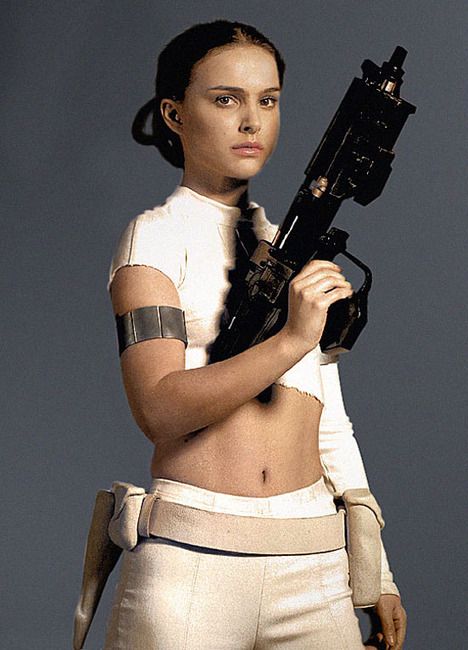
It's also worth noting in this regard that, unlike Lucas's later, more family-friendly films, THX 1138 featured onscreen nudity.
Starkiller manages to cut down several of the trappers, but one of them escapes in his vehicle with Princess Leia, and Annikin is knocked unconscious. However, in the chaos, several of the Wookees escape, and they take Annikin back to their village.
In the Wookee village, Annikin finds himself thrust into ritual combat with a Wookee warrior, Jommillia. Annikin holds his own in the fight until Auzituck, chief of the Sawa tribe of the Wookees, calls a halt to the affair. A great celebration with bonfires is put on to celebrate Starkiller's bravery, much like that seen in the ending of ROTJ.
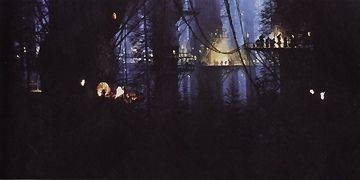
Annikin takes his leave of the Wookees, but one of the Wookees whose life he saved--Prince Chewbacca, son of Chief Auzituck--follows him in order to discharge his debt.
Meanwhile, the other heroes have met Owen Lars, a human settler, and his wife Beru. Han Solo and General Skywalker leave Leia's brothers in their care while they search for Annikin.
Annikin, Artwo, and Chewbacca at last meet up with General Skywalker and Han Solo. Realizing that Leia has been taken to a nearby Imperial outpost, they make a plan to use the Wookees--who hate the Empire and its trappers--to lead an assault on the base.
As an Imperial "air tank" makes a patrol through the jungle, it is ambushed by a squadron of Wookees, holding reflective metal shields that jam its radar. Starkiller and Skywalker overpower the occupants of the hover-tank and get in. Leading a column of Wookee soldiers, they use the captured tank to attack the feeble defenses of the Imperial base.
This scene would provide the inspiration for both the forest battle with AT-ST walkers seen in ROTJ, and the floating Trade Federation tanks seen in TPM.
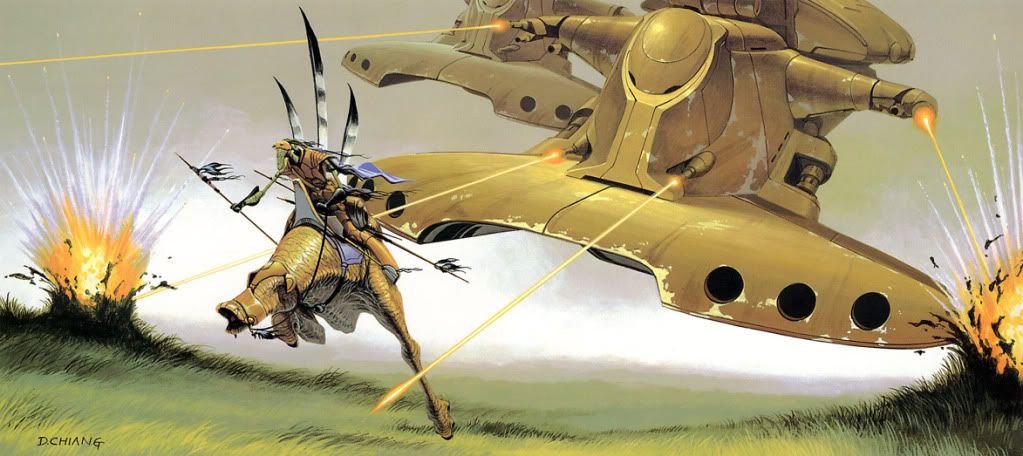
The attack is successful, leaving the rebels and Wookees in command of the outpost. However, they discover that Leia has been taken by ship back to Aquilae.
Meanwhile, a squadron of stormtroopers has raided Owen Lars' house, capturing Leia's brothers. Fortunately, the stormtroopers are intercepted by a patrol of Wookees. The boys and the Lars family are safely rescued.
While Han Solo arranges for an uprising on Aquilae via the rebel underground, General Skywalker begins to train the Wookees in spaceflight, using the captured Imperial starfighters of the outpost. The fighters themselves are four-man craft, described thus: "Bizarre and colorful Wookee designs have been painted across the large deflector fins of the spacecraft. Some designs transform the ships into huge and grotesque animals, while others create unique mosaic patterns."
The description of the patterns painted on the fighters by the Wookees is highly reminiscent of the dazzle-camouflage color schemes used on spaceships in the SF paintings of Chris Foss.
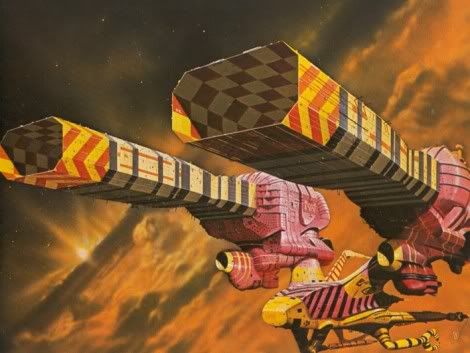
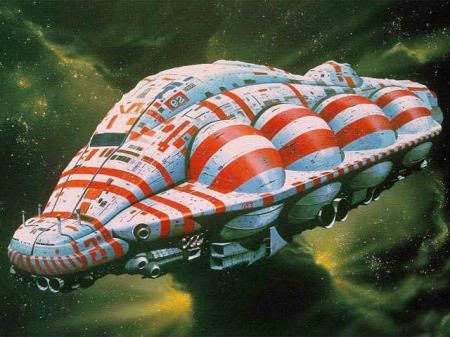
Meanwhile, Annikin Starkiller disguises himself as an Imperial pilot and sets out, accompanied only by Artwo, to infiltrate the space fortress over Aquilae and rescue Princess Leia.
Aboard the space station, Darth Vader interrogates Leia, using electric shocks in an attempt to break her will. Ultimately, however, Vader places his hopes in "doctors from Alderaan" who will operate on Leia to destroy her mind and render her pliant.
Starkiller arrives aboard the space station and steals a stormtrooper's uniform. However, he is detected and captured. Prince Valorum, now reduced to the rank of a stormtrooper after his earlier failure to capture the heroes, laments to Starkiller that he has come to a place where a warrior's honor is meaningless.
The ship bearing the doctors from Alderaan finally arrives, and Annikin is escorted to the airlock to meet it. Suddenly, however, Valorum cuts down his guards and frees Annikin. Valorum has realized the error of his ways; the Empire has no honor, and he must help the Jedi instead.
Valorum and Annikin free Leia as she is being led to the ship. The trio begin battling their way out of the Imperial space fortress.
Since Leia is apparently barefoot, bare-breasted, and carrying a gun in this scene, her costume here invokes more goddess symbolism: that of Liberty in Eugene Delacroix's famous French revolutionary painting Liberty Leading the People. Leia as the goddess Liberty suggests the necessity of revolution against the evil Empire; her companions, Valorum and Starkiller, represent those who fight for Liberty's cause.
As a bare-breasted woman in the middle of a labyrinth of white Imperial corridors, Leia also represents everything life-affirming that is lacking in the sterility of the Imperial ideology.
Outside the space fortress, the Wookees in their fighter squadrons arrive and begin their attack.
Needing an escape route from the fortress, the trio of heroes plunge down a garbage chute into a trash compactor. General Vader, seeing them on the security monitors, activates the garbage compactor. However, the Wookee fighters knock out the power to the compactor, and the heroes are saved.
As the space station reels under the Wookee assault, the trio run for the lifepods. At one point they have to hold on for their lives when a hole is blasted in the corridor, leading into open space. Finally they reach the lifepods. Valorum and Artwo take one pod, Starkiller and the princess the other.
The pods eject. The Wookees' assault on the space station's power conduits has begun a chain reaction. General Vader advises Governor Hoedaack to evacuate, but Hoedaack refuses to do so. The space station explodes. In their lifepod, Annikin and Leia kiss passionately.
In the film's final scene, we see all the heroes gathered in Leia's throne room on Aquilae: Annikin Starkiller, General Skywalker, Prince Valorum, the green-skinned Han Solo, and the Wookees. Leia is in the center of it all, seated on a throne, resplendent as Queen of Aquilae.
The equivalent scene in The Hidden Fortress has Princess Yuki wearing white geisha makeup, symbolically representing her as a goddess figure. Quite possibly the idea to do the same with Leia was already present in Lucas's mind. That impulse would finally be realized on screen with Queen Amidala in TPM.
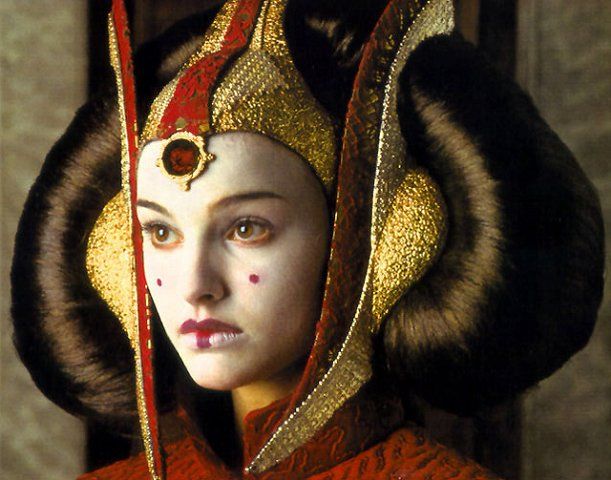
Leia rewards the two droids, R2-D2 and C-3PO, announcing that they will serve Annikin Starkiller, the new "Lord Protector of Aquilae" (i.e., Leia's consort on the throne).
With that scene, the rough draft ends.
---
As we can see, a LOT of the images from this rough draft would recur elsewhere in Lucas' later work. It's actually quite surprising how visually fleshed-out this draft was in Lucas's head.
Thoughts?
